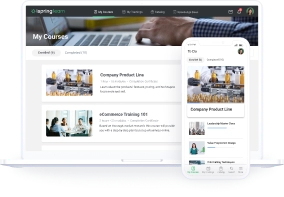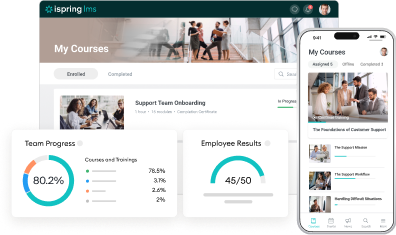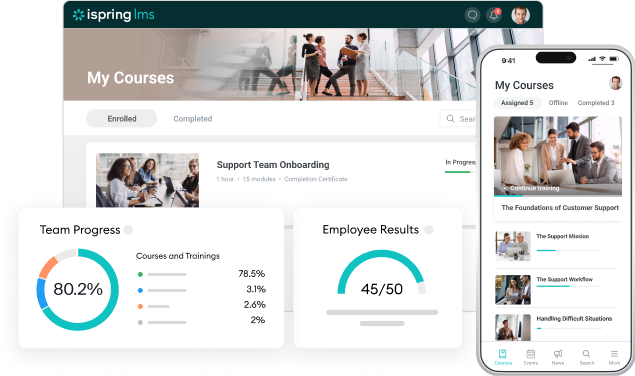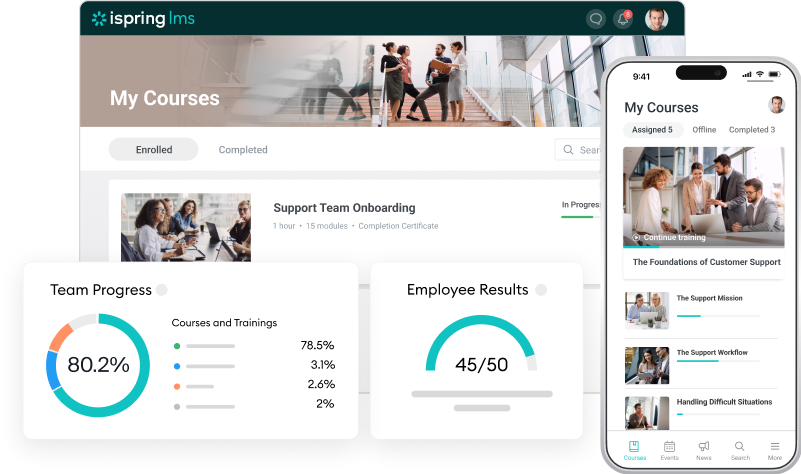The 9-Box Grid: What, How, and Why [Template Inside]
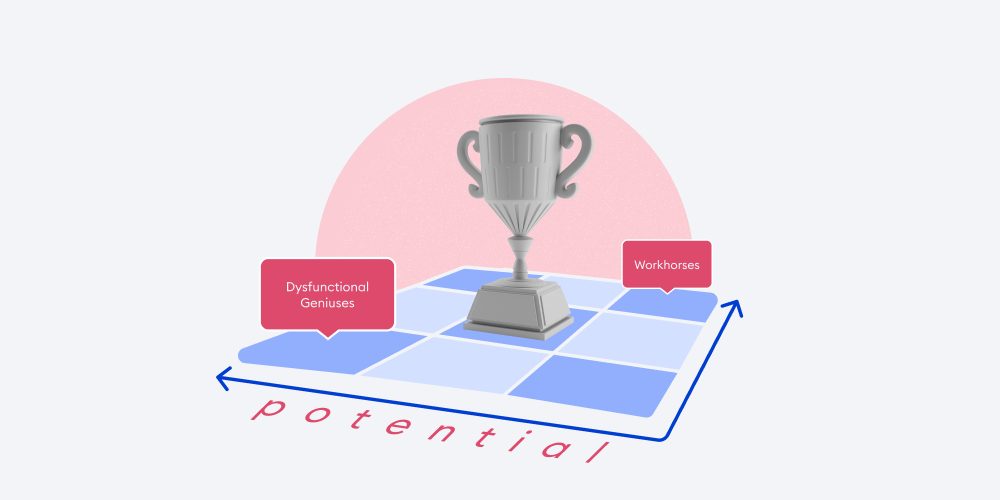
Summary: There is a lot of controversy surrounding the 9-box grid, a super-simple method of employee evaluation. Some experts consider it outdated and inaccurate, while other HR pros have been using it for years in their companies. In this article, you’ll learn everything you need to know before implementing the 9-Box Grid in your organization and get a comprehensive Excel template for a quick start.
The success of any business depends heavily on its people. There are enthusiastic and productive employees who go the extra mile every day to learn new things and improve their professionalism, those who do just enough to avoid getting fired because they feel misplaced or underappreciated, and heroes who could have been running the department long ago but don’t get recognized.
How do you find out who’s who? That’s where methods like the 9-Box Grid come in — a popular and simple tool that can help you identify those who are doing great, need a little push, or could be your next star leader. Have you used it in your organization? Share your experience in the comment section below! And if you’re thinking about giving it a try, check out this article — we break down what the 9-Box Grid is and how you can use it to get the best out of everyone in your team.
Table of contents:
- What is the 9-Box Grid?
- The benefits of the 9-Box Grid
- How to use the 9-Box Grid in performance management
- The 9-Box Grid template
- What’s wrong with the 9-Box Grid?
- Alternative ways to evaluate employee performance
What Is The 9-Box Grid?
The 9-Box Grid, or 9-Box Matrix, was created in 1970 by McKinsey, the global management consulting firm, for General Electric to help prioritize investments across its business units. Today, the 9-Box Grid is a framework that employers and HR professionals use to evaluate and map an organization’s talent pool along two axes: current performance and future potential.
Visually, it looks like a 3×3 matrix, where “x,” the horizontal axis, represents an employee’s current performance — whether they are below, meeting, or exceeding performance expectations, and “y,” the vertical axis, indicates their potential to grow into leadership roles.

The matrix helps HR teams classify employees using nine categories and then decide how to work with each of them so that everyone is satisfied with their position and the company runs more efficiently. Later in this article, we’ll discuss each quadrant of the matrix.
The Benefits of the 9-Box Grid
Although the 9-Box Grid method isn’t perfect, it has some real advantages that will make you want to use it:
Easy to implement and use
In the classic 9-Box Grid, there are no complex metrics or algorithms that would take a lot of time and effort to explain and understand. This simple scoring system is easy to use and quick to analyze. What’s more, it doesn’t cost a lot to implement because it can be done by regular managers without the need to hire outside experts or invest in specialized software.
Forward focused
The 9-Box Grid can help with long-term strategic planning by fostering a culture of development and progression where people are not just seen as they are, but as they could be. It ensures a talent pipeline for critical roles, a.k.a. succession planning, reducing the risk associated with sudden departures of key employees.
Versatile
The 9-Box Grid is highly adaptable to different organizational needs and contexts (it’s only worthwhile for what it was originally designed for), making it a versatile talent management tool. It can be used in any industry, startup, non-profit, small business, large corporation, across different departments, and from entry-level to senior leadership.
How to Use the 9-Box Grid in Performance Management
To create the 9-Box Grid, you need to have the results of two assessments: employee performance and potential. Then, merge them together, analyze the results, and take action.
Let’s break this process down step by step.
Step 1. Assess employee performance
Start with performance reviews by assessing individuals based on KPIs, job responsibilities, employee certifications, external expert reviews, and any other performance metrics your organization has established. It’s better to consider both quantitative and qualitative aspects to get a more complete understanding of how well employees are performing in their roles.
For the 9-Box Grid, you need to sort performance scores into three groups: low, moderate, and high. You can interpret these categories in different ways, depending on your position or the specifics of your organization. Here is the general interpretation to get you started:
| Low performance | The employee barely manages daily tasks and often fails to achieve the desired results. Assigning more challenging tasks is not feasible. |
| Moderate performance | The employee produces average results at the level expected, meets key indicators more than half the time, but doesn’t exceed goals. |
| High performance | The employee consistently excels at their job, completing complex tasks, and sometimes exceeding expectations. |
Step 2. Assess employee potential
There’s some confusion between performance and potential. To distinguish between the terms, let’s say that an employee’s performance is their past or current behavior, while potential is their expected future behavior — how much an employee is expected to grow in the future.
Assessing employee potential is less easy and common for organizations than performance reviews; that’s why HR managers and team leaders can face some difficulties. We suggest that you answer these questions to better understand if an employee has potential for strong growth:
- How well does the employee adapt to changes in their role or the organization? Can they easily adopt new technologies, methods, or work processes?
- Does the employee proactively seek out professional development opportunities?
- Are they open to taking on leadership or mentoring roles?
- Does the employee show initiative in taking on new projects or responsibilities without explicit direction?
- How well do they handle setbacks or challenges in the workplace?
Just like performance, employee potential also needs to be divided into three groups:
| Low potential | The employee isn’t expected to surpass their current performance, either because they have already reached their maximum capacity or due to a lack of motivation. |
| Moderate potential | Such employees have the potential to develop within their current job role. They have a stable performance but aren’t anticipated to surpass their current level significantly. |
| High potential | These are people who are ready for advancement. They exceed expectations, take on new responsibilities with enthusiasm, have strong communication and leadership skills, and are ambitious about their career goals. |
Step 3. Bring performance and potential together
Once you score all employees’ performance and potential, design a 3×3 grid and place them in the appropriate boxes:

In the top row are employees with the highest potential, and in the bottom row are those with low potential. In the middle is a wide range of options in between.
This 9-box grid represents your workforce visually and can give managers a clear view of each employee’s contributions and prospects.
Step 4. Analyze the results and take actions
If you thought that was it, the most important part and the purpose of creating the 9-Box Grid are just beginning! Now you need to analyze the results and determine the action plan for each group of employees. But first, you need to clearly understand what each box represents and how to work with it. Let’s take a closer look.
Bad hires

In the bottom left corner of the 9-Box Grid are the employees with low performance and potential. The name Bad Hires makes it clear that employees may be underperforming simply because they are in the wrong place, which may be partially the mistake of HR in hiring the wrong person for the job.
Being in the Bad Hires cell doesn’t necessarily mean the employee is lazy or lacks ambition. It’s more likely that they could have excelled in a different position or at a different company.
What can you do?
- Conduct a 1:1 meeting to identify barriers that are causing poor results.
- If there are objective factors, try to address them.
- If you have open positions, offer a transition to another role where the employee can utilize their abilities.
- When nothing works, consider terminating the employee, as they can threaten the success of your organization and demotivate other team members.
- Review the hiring process to reduce the likelihood of such employees in the future.
You can avoid “bad hires” with a well-oiled pre-boarding process organized with iSpring LMS. Simply upload and assign all the information, courses, psychological quizzes, and test tasks that candidates need to complete. When candidates complete the program, iSpring LMS will generate a detailed report with progress results for each candidate, so you can easily understand who is a good fit for the position, who you should say goodbye to, and who can be considered for a position that is more relevant to their skills and experience.
Up or out

These are employees with low potential and moderate performance (up or out grinders) and those with moderate potential and low performance (up or out dilemmas). They can easily be seen as a challenging group because these employees are doing enough to keep them from being fired, but still aren’t providing their best and have unclear prospects.
The reasons why employees might fall into this group vary. “Grinders” may lack motivation for growth or have some encumbering personal traits, while “dilemmas” often fall into this group due to a poor onboarding experience. They may simply not understand job expectations or some work processes.
What can you do?
- Discuss the reasons that prevent an employee from getting better results (if they understand the job responsibilities and core KPIs) and define whether their skills are sufficient or not.
- Reveal employee skill gaps and provide development opportunities through personalized training programs, peer learning, or mentorship programs.
- If the reason for their underperformance is a poor onboarding experience, conduct an induction training to help the employee understand their role in the company.
- Observe their development over time, as these types of employees tend to transition over time to higher performance or potential, or conversely, to lower ones.
When it comes to induction training, it’s much more efficient to execute this online with specialized training software. For example, with iSpring LMS, you can create and deliver comprehensive onboarding programs in just a few days, helping new team members reach their full potential and highest productivity faster.

Onboarding programs are conveniently organized by day or topic, making them digestible and easy to follow. New hires can access courses directly from their mobile phones, so they can hit the ground running and be better prepared to succeed.
Workhorses

Workhorses have high performance and low potential. They do their best at their jobs but are unlikely to aspire to a promotion or leadership role, either because of some personal trait or because they’ve become enamored with their current position and don’t want to change.
What can you do?
- Treat them like good employees: make sure their working conditions remain comfortable, reward them for success, and index their salaries regularly to keep these people compensated fairly.
- It’s best not to promote them, but it’s alright to include them in mentoring programs, invite them to share their expertise at some workshops, and help newcomers.
- If major changes are coming to the company and some old roles become irrelevant, prepare these people in advance. Organize training for them or offer horizontal promotions to avoid losing qualified and productive employees.
Dysfunctional geniuses

Dysfunctional geniuses, or untapped talents, are at the other end of the spectrum. They are ambitious and talented, but not currently performing at their best. They are enthusiastic but now lack experience, like fresh university graduates who jumped right into a new job in the industry.
What can you do?
- Explain assigned tasks to employees clearly, monitor progress, and reward good results.
- Discuss the criteria and KPIs that are used to measure work so employees understand what is expected of them.
- Give them opportunities to develop their skills through training programs and working with a mentor. In this way, these employees can become productive very quickly.
Employee training programs are easy to implement with iSpring LMS. What’s more, the process doesn’t even require your manual intervention. You only need to set the rules once and the platform will automatically assign courses to the appropriate group of learners, notify them of new courses, remind them of deadlines, and provide you with detailed reports on how your teams are progressing.
Core players and high potentials

Core players are in the middle of the performance and potential spectrum on the 9-Box Grid. This is the most stable group of employees who are really “in place”: they like their jobs and are therefore quite productive and satisfied. If the recruitment and onboarding processes are well organized, core players are also the largest group in the company.
“High Potentials” are future leaders and are like rising stars — they are already doing their jobs well and have the potential to rise even higher and take on leadership roles, but they lack the experience or expertise to do so. This is mostly because they haven’t had time to fully grow into the role.
What can you do?
We’ve combined these two quadrants because the strategy is much the same for both:
- Have regular 1:1s to make sure tasks are clear and motivation is high. Discuss prospects, ask what they want for the future, give feedback on their work, and celebrate successes.
- For those who want to do more, offer online training to fill knowledge and skill gaps, or assign a mentor to help them perform better. You can also try short-term rotations to give these employees new experiences.
- Focus on improving their performance and monitor their progress.
High performers

These are employees who move out of the “core players” box when L&D teams or employers have a great employee training plan. They’re strong contributors who perform super well and have moderate potential to perform even better in the future. They’re happy with their position overall, but wouldn’t mind moving up. In this case, they can move to the Stars group.
What can you do?
- Discuss desired career paths. If an employee is happy with their job and isn’t looking for a promotion, just keep them engaged and happy in their position.
- If they want to do more, gradually expand their responsibilities and give them more challenging assignments.
- Offer them a promotion in the future if there are openings in the company.
Stars

Stars are the undisputed leaders in the organization. They are often those who have been with the company for 3-5 years or more, are performing their jobs perfectly, and still have potential for further success. Stars are always first in line for promotions, challenging assignments, and ambitious projects.
What can you do?
- Do your best to keep them engaged. Evaluate their work enthusiasm 2-3 times a year and make sure they don’t get bored with their daily tasks.
- These employees can’t do routine work for long. Assign them challenging tasks to allow them to express their potential.
- If they’re bored and there are no leadership positions available, offer them a horizontal promotion — a role with a slightly different skill set to help them grow in a different direction and stay excited about their jobs.
- Raise their public profile. Involve them in mentoring programs as mentors, and invite them to meetups to speak out.
The 9-Box Grid Template
As we’ve already mentioned, you don’t need complex software to perform a 9-box grid assessment. To make your job even easier, we’ve prepared a ready-made template. So, if you decide to use it in your organization, all you need to do is download it, write each employee’s potential and performance, and place them on the grid according to the quadrants.
Download the free 9-Box Grid template →
What’s Wrong with the 9-Box Grid?
Although the 9-Box Grid method is versatile and can really help you gain some insights into the performance and potential of employees, it is also subject to a lot of criticism and complaints from HR managers and employers. Let’s cover some common points:
Subjectivity and biases
One of the significant issues with the 9-Box Grid is subjectivity in evaluations. Since the grid relies heavily on managerial judgment, there’s a risk of personal biases. The managers evaluating employees may have only surface-level information or some personal beliefs that skew the results. This can lead to unfair evaluations and missed opportunities for some employees.
It’s hard to gauge people’s potential
Often, the organizations and managers conducting the 9-Box Grid assessment don’t perceive the difference between performance and potential or simply don’t know what potential to expect from their employees in the future. And that makes sense — an employee’s performance in one role is unlikely to be a factor in their ability to excel in more challenging roles or leadership positions.
Labeling employees and lowering their morale
No one wants to be put into boxes. With the 9-Box Grid as a framework, it’s easy to typecast employees — to pigeonhole them into a specific label that’s hard to shake. Once an employee is placed in a certain box, it can create a fixed perception of their talents and abilities.
What’s more, this label can be particularly damaging if it’s not accurate or if an employee’s performance changes over time, limiting their growth and career development or promoting them into a role that they’re not suited for. Such a stigma can affect an employee’s self-esteem and engagement, making it harder for them to progress.
“Every role and every employee’s productivity are contextual. The 9-Box Grid doesn’t take the many circumstances that affect an employee’s performance into account.
You can’t abstract that away and rely solely on your internal feelings about a person’s performance and potential. That’s why it’s better to use the 9-Box Grid in conjunction with other, more precise and comprehensive methods.”

Alternative Ways to Evaluate Employee Performance
In addition to the 9-Box Grid, there are an infinite number of methods and frameworks for assessing performance. We’ll mention a few here to broaden your perspective and help you choose the one that best fits your needs:
360-degree assessment

The Radar Chart provides a visual representation of what subordinates, peers, managers, and customers think of the employee.
A 360-degree review is a comprehensive approach that allows you to gather feedback on an employee’s performance from all angles: superiors, peers, subordinates, and even customers, providing a multiperspective view of an employee’s skills, productivity, and behavior in the workplace. It also includes a self-assessment, so you can check whether the employee’s vision is in line with how their work is perceived by the team.
Such a performance evaluation can be easily implemented online, directly in iSpring LMS, so there’s no need to collect feedback manually and then spend days analyzing the results. All you need to do is define the competencies for a particular role, set a rating scale of 1 to 5 or 10 points for each of them, and select the respondents. iSpring LMS will notify those who need to complete a questionnaire, collect their anonymous input, and generate detailed reports with extensive analytics.
Pros
- Provides a holistic and balanced view of employee performance
- Helps identify blind spots and increases self-awareness
- Easy to conduct with specialized 360-degree feedback software
Cons
- Can still be influenced by favoritism
- Risk of non-constructive feedback
- Can be time consuming
Behaviorally anchored rating scales (BARS)
Behaviorally Anchored Rating Scales (BARS) is a method that compares employee behaviors to specific examples of behaviors that are anchored to a numerical rating (usually on a 5-, 7-, or 9-point scale).
Each performance level on a BAR scale is anchored by a set of statements that describe common behaviors that an employee typically demonstrates. The statements serve as a benchmark for measuring an individual’s performance against predetermined standards for their role or job grade.
Pros
- Combines qualitative and quantitative data
- Evaluation based on specific behavior rather than subjective feelings
Cons
- Appraisers might interpret behavior differently
- Behavioral benchmarks need to be updated regularly
Human resource (cost) accounting
Human resource (cost) accounting is a method of quantifying the value of human resources within an organization. This assesses employee performance in terms of the cost of retaining an employee and the contribution (monetary benefits) the organization receives from a particular employee.
Pros
- Enables employers to assess the return on investment (ROI) for various human resource activities
- Helps identify those who deserve bonuses or promotions and those who need training
Cons
- Many projects and campaigns are the result of collaborative efforts involving multiple people, teams, and departments, making it difficult to attribute them solely to one person’s contribution
- Not all efforts and types of work are inherently digitizable
FAQ on The 9-Box Grid
Check out the most common questions about the 9-Box Grid that we haven’t mentioned yet:
1. How do I prioritize investments in employees based on the 9-Box Grid?
The 9-Box Grid can also help identify where to allocate resources and training efforts. Imagine if you had $100 that you have to distribute among employees. HR teams recommend doing so this way:

The logic is simple: invest in the people who are truly engaged and add value to the organization. And don’t invest much in those whose work doesn’t produce the expected results because those investment efforts won’t pay off.
2. Who should conduct the 9-Box Grid assessment in an organization?
The 9-Box Grid assessment is typically a collaborative process involving HR professionals and the leadership team: direct supervisors or managers, senior leadership, and occasionally team leaders or project managers.
HR coordinates the process, while managers provide direct insights into their team members’ performance. Senior leadership’s involvement ensures strategic alignment with organizational goals. In some cases, employee self-assessment is also incorporated to provide additional perspective and foster engagement in their development. Training for assessors is crucial to ensure effective and unbiased use of the tool.
Final Tips
That’s it! We hope you found this article useful. Here are the key takeaways from the 9-Box Grid:
- The 9-Box Grid can be effective for talent management. It really helps to segment employees and make informed decisions in succession planning or implementing future training activities.
- Think outside the box. The “value” of employees is more than just their potential and performance. When you place your employees on the grid, think about why they are there: what has prevented them from achieving more, and what personal issues may be behind it. Maintain open and honest communication, and remember that the results of an assessment quickly become outdated.
- Don’t perform the 9-Box Grid evaluation just for the sake of an evaluation. Before you start an employee assessment, make sure you’re ready for the next steps in talent management. It’s first necessary to have all the tools and resources you need to deliver employee development programs and personalized learning paths.
If you don’t have reliable training software, take a look at iSpring LMS. Experience the LMS firsthand with a 30-day trial or sign up for a free live demo where our eLearning experts will walk you through the platform’s features and help you decide if it’s right for your business.
